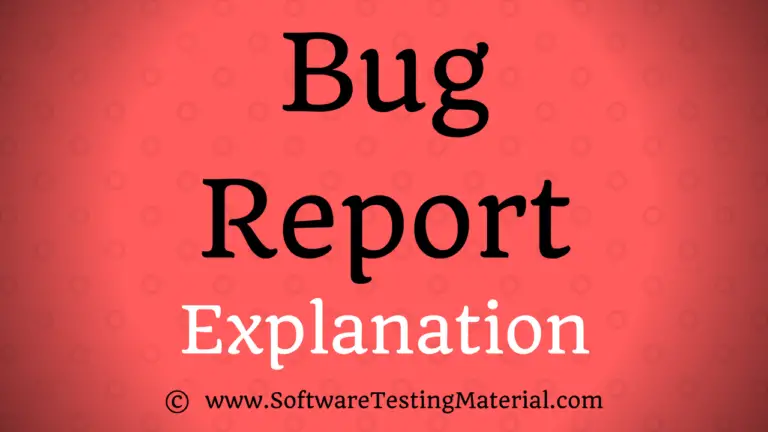Regression Testing Guide | Why Is Automated Regression Testing A Must?

In this article we will learn what is regression testing, what is automated regression testing and the following.
What is Regression Testing with example?
Regression testing is a type of software testing that seeks to identify bugs or errors in software code that was previously working correctly.
This testing is typically performed after new code has been added or modified, in order to ensure that the new code does not break existing functionality.
Regression tests can be run manually or automated, and there are various tools available to help with both approaches.
In simple words, We do regression by re-executing the tests against the modified application to evaluate whether the modified code breaks anything which was working earlier.
Anytime we do modify an application, we should do regression testing (we run regression test).
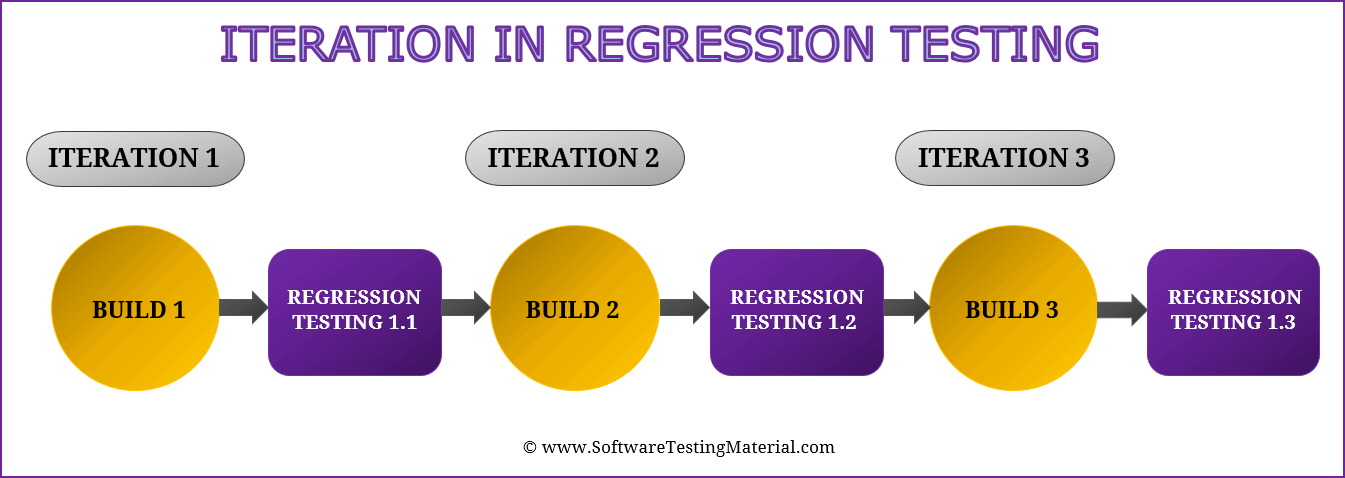
Also Read: What is Retesting? When Do We Do Retesting?
Regression testing gives confidence to the developers that there is no broken functionality after modifying the production code.
It makes sure that there are no unexpected side effects. Hope you have understood what is regression tests. Now let’s see when do we do this type of testing.
Regression Testing Example
Assume there is an application which has a functionality to ‘Add’, ‘Save’, and ‘Delete’. These functions allow users to add data, save data and delete data. Now developers are developing a new feature i.e., ‘Update’. This feature allows users to edit and update the data. As a tester, you have to verify the introduction of a new feature (ie., Update) impacting the existing features (such as ‘Add’, ‘Save’, and ‘Delete’ functions) or not.
Check the below video to see “What is Regression Testing, when and how to perform it“
If you liked this video, then please subscribe to our YouTube Channel for more video tutorials.
What are the types of Regression Testing?
There are three types of Regression Testing.
- Unit Regression
- Partial Regression
- Complete Regression
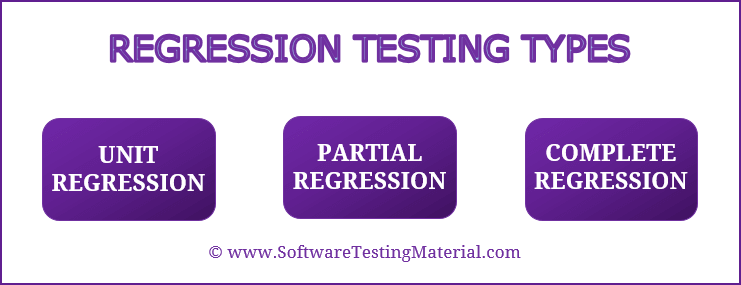
#1. Unit Regression
Unit Regression Testing is done during the unit testing phase and the code is tested as a single unit without any dependencies. Dependencies if any are temporarily blocked to test the unit independently.
In this, we are going to test only the changed unit, not the impact area, because it may affect the components of the same module.
Assume there is a form to accept user details such as First Name (accept only alphabets of max 10 characters), Last Name (accept only alphabets of max 10 characters), Emai Id (accept alphabets, numbers & special characters of max 30 characters).
Based on the test case design techniques, testers test the above form once the build is released.
Once the development team releases the build (B0001), testers start testing this build to verify whether the form is working as expected or not.
If the client request some modificiations in the form say the First name and Last name filed should accept max 15 characters instead of previously given 10 characters.
Developers will modify the functionality and release another build (B0002) and testers here test only whether the First name and Last name accepts max 15 characters or not and wont check any other features of the first build (B0001).
Here, testers are sure that the increase in the character count in the First name and Last name fields wont affect the form functionality, so they test only the character count.
Testing only the modified feature is known as Unit Regreession Testing.
#2. Partial Regression
Partial Regression Testing means when regression testing is done on a module where the change in the code is related to that particular module and there wont be any change impact on other modules.
It is also known as Regional Regression Testing.
Assume we have Login page along with User details form. If the tester finds a defect (D0001) in the form functionality and reported it.
Developers fix it and release another build (say B0003) which contains bug fix.
While testing the build (B0003), testers identify tha the bug fixing in the User details form impacts Login Page.
So testers test the bug fix first and then tests the Login page functionality.
Pro Tip: Whenever a build is released, as a tester you need to following the order – perform smoke test, test newly released features, test modified features, retest the bugs, test the impact areas by performing the regional regression testing.
#3. Complete Regression
Complete Regression Testing means when regression testing is done on a number of modules where the change in the code is related to the other module is uncertain.
It is also known as Full Regression Testing.
If there are new features and some bug fixes in a build. Test team will do the impact analysis. If they identify that the new build will lead to test the entire application then they perform testing the new features along with all the existing features.
Automated Regression Testing Techniques
Software maintenance is the process of modifying a software application which includes improvements, bug fixing, deletion of existing features, and optimization. When we do these modifications, the system may work incorrectly. To avoid issues while modifying the code, we do follow regression testing techniques. These techniques help us to eliminate the risks associated with the modifying code.
Following are the various techniques for automated regression testing.
- Retest All
- Regression Test Selection
- Test Case Prioritization
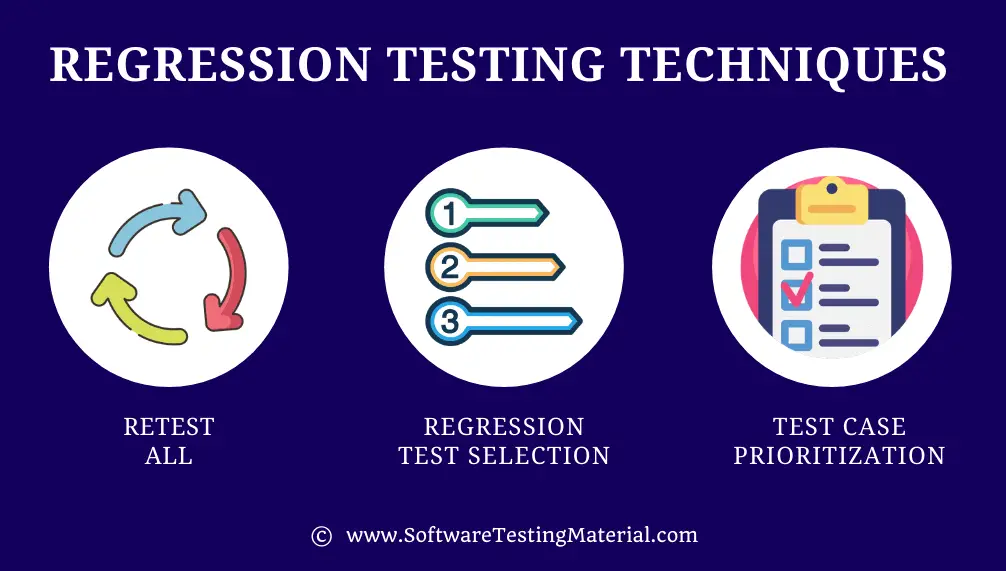
#1. Retest All
All the test cases in the existing test bucket or test suite are re-executed to verify that there are no bugs that occurred due to the modified code.
This is a very expensive method as it needs enormous time as well as resources when compared to the other techniques.
#2. Regression Test Selection
By using the regression test selection technique, we select a part of test cases from the test suite to run to verify whether the modified code affects the application or not instead of re-executing the complete test suite. This selection of test cases from the test suite is done on the basis of the modified code. The test cases chosen are categorized into two parts such as reusable test cases and obsolete test cases.
Reusable test cases – Test cases that can be used in succeeding regression cycles.
Obsolete test case – Test cases that cannot be used in succeeding regression cycles.
#3. Test Case Prioritization
By using this technique, we select the test cases with high priority first to run instead of a medium and low priority ones. Test case priority depends on its business impact, frequency, and criticality. Running high-priority test cases first can save time and money while finding the most defects. This approach is especially handy when dealing with a large codebase.
Difference Between Re-Testing and Regression Testing
Retesting is a testing types to test the functionality or bug again to ensure that the defects which were found and posted in the earlier build were fixed or not in the latest build.
Regression testing is a testing types to repeat the testing of an already tested program, after modifications, to discover any defects introduced or uncovered as a result of the changes in the software being tested or in another related or unrelated software component.
Most of the time testers get confused with both regression and retesting. As a tester you have to remember that both these regression testing and retesting are different. You can read the complete list of differences between Regression Testing vs Retesting in detail here.
When do we do Regression Check?
Interviewers may ask you why do you do regression testing. We do software regression testing whenever the production code is modified. Usually, we do execute regression tests in the following cases:
Some regression tests examples are here.
#1. When new functionalities are added to the application
Example: A website has a login functionality that allows users to do login only with Email. Now the new features look like “providing a new feature to do login using Facebook”.
#2. When there is a Change Requirement (CR)
Example: Remember password should be removed from the login page which is available earlier.
#3. When there is a Defect Fix
Example: Imagine the Login button is not working on a login page and a tester reports a bug stating that the login button is broken. Once the bug is fixed by the developers, testers test it to make sure whether the Login button is working as per the expected result. Simultaneously testers test other functionalities that are related to the login button.
#4. When there is a Performance Issue Fix
Example: Loading the home page takes 5 seconds. Reducing the load time to 2 seconds.
#5. When there is an Environment change
Example: Updating the Database from MySQL to Oracle.
So far we have seen what is regression and when do we do regression. Now let’s see how we do it.
How do we perform Regression Testing?
Steps to carry out to perform regression tests are
- Step #1: Get clear understanding on what are the changes made to the software
- Step #2: Analyse which part of the software might be impacted with the modified code
- Step #3: Make sure whether you have to follow which type of regression such as Unit, Partial, or Full regression.
- Step #4: Execute the selected test cases.
What is Automated Regression Testing?
Automated regression testing in software development automates the execution of regression test suites to ensure new code changes don’t harm existing functionality.
Automated regression testing uses specialized tools and scripts to automatically execute predefined test cases. It quickly identifies issues by running predefined tests. This method saves time, catches bugs early, and can be scheduled to run continuously, enhancing the product’s stability and reliability before release.
Why Automated Regression Testing?
Regression tests are generally extremely tedious and time-consuming.
We do regression after every deployment, so it would make life easy to automate test cases instead of running manually each and every time.
If we have thousands of test cases, it’s better to create automation test scripts for the test cases which we do on every build (i.e., regression testing)
Automated regression test is the best practice and it is the choice of organizations to save a lot of time and to run nightly builds.
When using automation for regression testing, it is important to consider the frequency with which the tests will be run.
For example, if the codebase is constantly changing, it may be necessary to run the tests on a nightly basis. Alternatively, if the code is only changed occasionally, it may be possible to run the tests less frequently.
It is also important to consider the impact of false positives when automation is used for regression testing.
A false positive is when a test incorrectly reports a bug or error.
This can happen for various reasons, such as changes in the environment, code that is no longer used, or incorrect test cases.
If false positives are not properly handled, they can cause significant problems, such as wasted time and resources investigating bugs that don’t actually exist.
How to Perform Automated Regression Testing
Performing automated regression testing involves several key steps to ensure the process is efficient and effective. Here is a detailed guide on how to perform automated regression testing in simple and easy-to-understand English:
- Identify Test Cases for Automation: Start by identifying which test cases are suitable for automation. Focus on repetitive tests that cover critical functionalities of the application. These could include previous bug fixes, core features, and areas most impacted by recent changes.
- Choose the Right Tools: Select appropriate automation tools based on your project requirements. Popular tools for automated regression testing include Selenium, QTP (Quick Test Professional), and JUnit. Consider the tools’ compatibility with the technology stack used in your application.
- Set Up the Testing Environment: Ensure your testing environment is stable and mirrors the production environment closely. Install all necessary software, libraries, and tools required to execute the tests.
- Create Automated Test Scripts: Develop test scripts that will perform the predefined test cases automatically. These scripts can be written in various programming languages like Java, Python, or JavaScript, depending on the automation tool you are using. Make sure the scripts are modular and reusable.
- Data Preparation: Prepare the necessary test data that will be used during the test execution. Ensure the data is realistic and comprehensive enough to cover various scenarios.
- Run the Tests: Execute the automated test scripts using the selected tools. You can schedule the tests to run at specific times, such as during off-peak hours or overnight, to avoid disruptions in the development process.
- Analyze Test Results: Once the tests have run, review the test results carefully. Automated tools often provide detailed reports highlighting which tests passed, failed, or encountered issues. Analyze these results to identify any bugs or discrepancies.
- Update and Maintain Test Scripts: Regularly update the automated test scripts to reflect any changes in the application. Maintenance is crucial to ensure that the scripts remain effective and continue to cover all critical functionalities correctly.
- Continuous Integration: Integrate automated regression testing into your continuous integration (CI) pipeline. This allows tests to be run automatically every time new code is committed, ensuring continuous validation of the software.
By following these steps, you can perform automated regression testing efficiently, helping to maintain the stability and reliability of your software through continuous and thorough testing.
Benefits of Automated Regression Testing
Automated regression testing offers several key benefits for software development:
- Saves Time: Running tests automatically is much faster than doing them manually. This saves time, allowing developers to focus on other important tasks.
- Improves Accuracy: Automated tests remove the risk of human error. They consistently perform the same steps and can be run many times with reliable results.
- Increases Test Coverage: More test cases can be executed in less time, ensuring that more parts of the application are tested thoroughly.
- Enhances Productivity: With faster and more accurate testing, the development team can release updates more frequently, keeping the software up-to-date and competitive.
- Provides Quick Feedback: Automated tests run every time new code is added, giving immediate feedback on any issues. This helps detect and address problems early in the development cycle.
- Ensures Consistency: Automated tests can be run in the same way every time, ensuring that the application behaves as expected across different environments and scenarios.
By leveraging these benefits, automated regression testing significantly contributes to a more efficient, reliable, and scalable software development process.
What are the Challenges of Regression Test Automation
There are some challenges in performing regression testing, even though it plays a crucial role in the QA process.
#1. Right Tool
Selecting the appropriate tool plays a key role in the success of regression test automation. If we select an inappropriate tool then regression test automation will become time-consuming and won’t generate good ROI.
#2. Resources
To utilize the selected tool in a proper manner to generate good ROI, we need to have skilled resources who can use the tool effectively.
#3. Time Consuming
Regression testing involves running the same test cases again and again. It leads to large test suites and consumes more time to complete the test execution. Sometimes due to time constraints, we may not run the entire regression test suite.
#4. Test Coverage
To overcome the time consumption, we have to minimize the test suites. We may not achieve maximum test coverage when minimizing the test suites.
Must read: Test Automation vs Automation Testing
Reasons Why Automated Regression Testing Could Be Right for Your Project
Automated regression testing offers several advantages that could make it the perfect choice for your project:
- Time-Saving: Automated tests run faster than manual tests, allowing you to complete your testing process more quickly. This is especially helpful for large projects with frequent updates.
- Consistency: Automation ensures that the same tests are run in the same way every time, reducing the risk of human error that can occur in manual testing.
- Cost-Effective: While there may be an initial investment in setting up automated tests, they save money in the long run by reducing the need for manual testers and catching defects early.
- Scalability: Automated tests can easily be scaled to cover more features and handle more complex test cases without a significant increase in effort or time.
- Repeatability: Automated regression tests can be run as often as needed without extra cost or effort, ensuring continuous validation of your software’s stability after every change.
What is Configuration Management During Regreesion Testing
In Agile Environments, Configuration Management in the regression testing becomes critical where code is frequently changed.
We must follow these steps in order to create a effective regression tests:
- During the regression test phase, no modifications should be permitted to the code. Developer changes must be kept out of regression test code.
- The regression test data must be kept isolated. No modifications to the database are permitted.
- The code being tested should be under a configuration management tool.
Must read: Configuration Testing Tutorial
Regression Testing in Agile
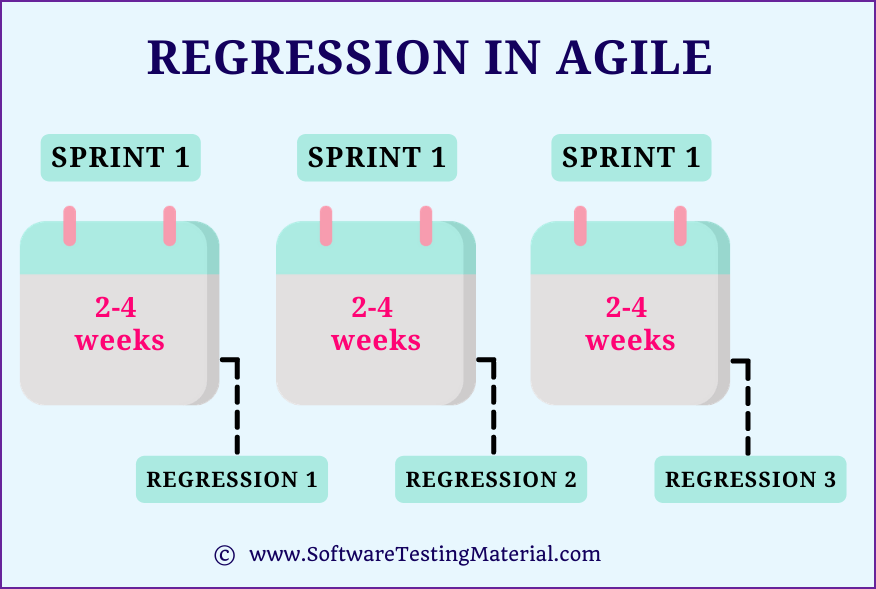
Now adays, most of the organizations are following Agile practices. Agile works in an iterative and incremental method. Developers work on new functionality and release them in every 2-4 weeks as sprint release. In agile, it is sure that for every 2-4 weeks once there will be a code change. In this case, the regression tests help in testing the new code change in every iteration to make sure that tested application continues to perform correctly after every iteration.
Best Practices of Regression Testing
Following are some of the best practices to be followed while doing this testing.
- Select the test cases that causes frequent defects.
- Select the work flow that has more visibility to the users.
- Conduct regression tests after smoke and sanity testing.
- Conduct regression tests at the end of functional testing.
- Have a regression test plan handy.
- Run regression test cases regularly to avoid the release risk in the next build.
- Use right tool to speed up the test process.
- Select all integration test cases, complex test cases, boundary value test cases.
Must read: Types of Test Cases To Be Automated and we Types of Test Cases Not To Be Automated
Automated Regression Test Tools
In most cases, the software undergoes frequent changes and we spent a lot of time to execute these regression test cases and which leads to high-cost and time consuming.
To avoid these problems we can choose automated regression tests.
Automation testing is a great way to run regression tests in efficient and cost effective way. It also helps testers not to test the repeated and boring tests.
In general, regression test suites have to be updated frequently. So while selecting a tool for your needs make sure the tool has the ability to update a test suite.
Here are some of the tools for regression testing that help you in automating your regression test cases efficiently and quickly.
#1. Selenium
Selenium is a free and open source test automation tool that is used to automate web applications. It can be used to test web-based applications on all major browsers, including Firefox, Chrome, Internet Explorer, Safari and Opera. Selenium can also be used to test mobile apps on Android and iOS platforms.
#2. Katalon
Katalon Studio is a powerful automated testing tool that can be used for both web testing and mobile testing. It supports many popular programming languages such as Java, Python, Ruby, Groovy, and C#. It helps testers save time and money by automating web, API, and mobile testing.
It comes with Katalon Recorder which acts as a record and playback tool.
Katalon Studio IDE supports the creation of test cases in Java and groovy.
#3. Ranorex
Ranorex Studio is a codeless test automation tool that enables testers to create, maintain, and execute automated tests for desktop, web, and mobile applications. Ranorex provides an all-in-one solution for end-to-end test automation, including support for Ranorex Studio – an integrated development environment (IDE) for creating and maintaining Ranorex test cases.
Ranorex also integrates with popular continuous integration (CI) systems such as Jenkins and TeamCity, making it easy to set up automated testing workflows.Ranorex supports testing on a wide variety of platforms, including Windows, macOS, and Linux. Ranorex tests can be executed on physical devices or emulators/simulators.
Must read: Best Regression Testing Tools
Advantages and Disadvantages
Advantages of Regression Testing
- It can be automated.
- Checks for code changes to ensure that they do not negatively impact other features.
- It improves the quality of the application.
- Ensure that already fixed issues and bugs are not repeated.
- During testing, it acts as a risk-mitigation approach.
Disadvantages of Regression Testing
- Regression testing might be time-consuming task without automating it.
- It must be done for every small change in the software code.
- We need to design complicated test cases to perform regression testing.
- Every time in an agile sprint, regression testing should be repeated.
Conclusion
Regression testing saves time and money. It helps organizations to deliver a quality product by ensuring that the code change should not affect the existing functionality.
FAQs – Automated Regression Testing Tools
Which tool is best for Automated Regression Testing?
There are many tools available for automated regression testing, but some stand out for their ease of use and powerful features. Selenium is one of the most popular tools because it’s open-source and supports many programming languages. Choosing the right tool depends on your specific needs and the technologies your project uses.
How to Select Regression Test Cases for Automation?
Selecting regression test cases for automation is straightforward if you follow a few simple steps. First, focus on areas of the application that are frequently used, as these are critical for users. Next, prioritize test cases that cover core features and functionalities to ensure the main components work correctly. It’s also important to include test cases for any recent bug fixes to verify they remain resolved. Lastly, automate tests that are time-consuming or labor-intensive when done manually to save effort and increase efficiency.
When does Automated Regression Testing work best?
Automated regression testing works best when you have test cases that need to be repeated often. It is ideal for stable features that do not change much over time. This type of testing is also very useful for large projects where manual testing would take too long. By using automated tests, you can quickly check for bugs every time you update your application, making sure everything still works correctly.
Can Regression Test Cases Be Automated?
Yes, regression test cases can be automated. Automation involves using tools to run tests without manual intervention. This helps ensure that changes in the code do not break existing features. Automated tests save time and reduce the effort needed for testing, making the process more efficient and reliable.
Can Regression Testing Be Automated?
Absolutely, regression testing can be automated using regression testing tools. Automated regression testing is a way to make sure changes in the code do not break existing features. By using automated tools to run tests, we can quickly find and fix any new issues, saving time and effort compared to manual testing. This helps keep software reliable and of high quality.
Why you should automate Regression Testing?
Automating regression testing is essential because it saves time and reduces costs. Manual testing of repeated tasks can be lengthy and prone to human error, whereas automated tests can run quickly and accurately. This efficiency allows testers to focus on new issues, improving the overall quality of the software. Moreover, automated tests can be run anytime, providing continuous feedback and ensuring that updates don’t break existing functionality.
What is Automated Visual Regression Testing?
Automated visual regression testing means using visual regression testing tools to check if the visual appearance of your application changes in an unwanted way after making updates or changes. This kind of testing compares screenshots of the application before and after changes to spot any unintentional differences. It helps ensure that the look and feel of the application remain consistent, saving time and effort by automating the process.
What are automated regression testing tools?
Automated regression testing tools are software programs that help testers check for bugs in an application after changes are made. These tools run tests automatically, saving time and effort compared to doing it manually. They are especially useful for ensuring that new updates do not break existing features in the application. Some popular automated regression testing tools include Selenium, and QTP. These tools help make sure the software is reliable and works as expected before it is released.
How to choose the right Regression Testing Tools?
Choosing the right regression testing tools can make a big difference in your software testing process. First, consider the features you need, like ease of use, compatibility with your application, and support for multiple test environments. Look for tools that integrate well with your existing software and development processes. Also, check the support and community around the tool, as good support can help you solve issues quickly. Lastly, consider the cost and whether it fits your budget. Tools like Selenium are open-source, which can be a cost-effective choice. By evaluating these factors, you can select a tool that will best meet your testing needs.
Why is Automated Regression Testing a must?
Automated regression testing is essential because it helps to quickly find bugs and issues after updates, making sure the software still works correctly. It saves time by running tests automatically instead of manually, allowing developers to focus on new features. This type of testing also ensures consistent and reliable results, which improves the overall quality of the software. In fast-paced development environments, automated tests provide quick feedback, helping to keep projects on track and within deadlines.
What are the challenges of Automated Regression Testing in Agile?
Automated regression testing in agile environments can be challenging. One major issue is the frequent changes in features, which can break tests and require constant updates to the test scripts. Additionally, maintaining a large suite of automated tests can be time-consuming. Integrating these tests into fast-paced agile workflows can sometimes slow down the development process. Lastly, finding skilled testers who can write and maintain automated tests effectively is often difficult.
Related posts:
- Manual Testing Tutorial
- Unit Testing Tutorial
- Integration Testing Tutorial
- Functional Testing Tutorial
- System Testing Tutorial
- Automated Visual Regression Testing Tools
- Visual Regression Testing Tutorial



